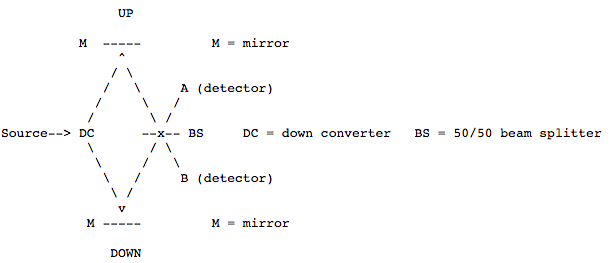7.26: Two Photon Interference - The Creation of an Entangled Superposition
- Page ID
- 142141
In this experiment a down converter, DC, converts an incident photon into two lower energy photons. One photon takes the upper path and the other the lower path. The results of this experiment are that both photons are detected at either A or B. One photon is never detected at A while the other is detected at B. A quantum mechanical analysis of this phenomena is provided below.

After the down converter the initial photon leaving the source has evolved into a state which is an entangled linear superposition.
\[ | Source \rangle \frac{[ |up \rangle_1 |down \rangle_2 + |down \rangle_1 |up \rangle_2 ]}{ 2^{ \frac{1}{2}}} \label{eq1} \]
This is an entangled state (non-factorable) because it acknowledges that it is unknown which photon takes which path. It also incorporates the fact that photons are bosons and consequently the state function must be symmetric with respect to interchange of the coordinates (paths) of the photons. If photons were fermions, |Source> would have to be antisymmetric with respect interchange of coordinates and the positive sign in Equation \ref{eq.1} would be replaced with a negative sign.
A photon that takes the upper path has a 50% chance of being detected at A or B. To reach A it must be reflected at the beam splitter and to reach B is must be transmitted. Conservation of energy requires a 90 degree phase difference between transmission and reflection, and by convention this phase difference is assigned to reflection. To reach detector A the upper photon must undergo a reflection at the beam splitter and its phase shift is recorded by multiplying |A> by i [(-1)1/2]. Thus in terms of the detector states |A> and |B> the photon taking the upper path evolves into the state shown in Equation \ref{eq2}.
\[ | up \rangle \frac{[ i |A \rangle + | B \rangle ]}{ 2^{ \frac{1}{2}}} \label{eq2} \]
Similar arguments show that the photon taking the lower path will evolve to the state given by Equation \ref{eq3}.
\[ | down \rangle \frac{[ i |A \rangle + | B \rangle ]}{ 2^{ \frac{1}{2}}} \label{eq3} \]
When Equations \ref{eq2} and \ref{eq3} are substituted into Equation \ref{eq1}, the following final state results (A and B represent the detectors, while 1 and 2 designate the photons):
\[ |Source \rangle \frac{[i | A \rangle_1 |A \rangle_2 + i^2 | A \rangle_1 B \rangle_2 + |B \rangle_1 |A \rangle_2 + i|B \rangle_1 |B \rangle_2 + i | A \rangle_1 |A \rangle_2 + | A \rangle_1 |B \rangle_2 + i^2 |B \rangle_1 |A \rangle_2 + i|B \rangle_1 |B \rangle_2]}{ 2^{ \frac{3}{2}}} \nonumber \]
Thus there eight final probability amplitudes, and they come in four pairs as can be seen above. However, two of the pairs destructively interfer (see note below) with each other and the final state is,
\[ | Source \rangle \frac{[ i|A \rangle_1 |A \rangle_2 + i|B \rangle_1 |B \rangle_2]}{ 2^{ \frac{1}{2}}} \nonumber \]
The probability of an outcome is found by taking the square of the absolute magnitude of its probability amplitude. Thus the probability that both photons will be recorded at A or both photons will be recorded at B is calculated as follows:
\[ P(AA) = \left| \frac{i}{2} ^{ \frac{1}{2}}\right|^2 = \frac{1}{2} \nonumber \]
\[ P(BB) = \left| \frac{i}{2} ^{ \frac{1}{2}}\right|^2 = \frac{1}{2} \nonumber \]
It was noted earlier that fermions require anti-symmetric state functions. So if this experiment could be performed with fermions Equation \ref{eq1} would become,
\[ | Source \rangle \frac{[|up \rangle_1 |down \rangle_2 - |down \rangle_1 |up \rangle_2 ]}{ 2^{ \frac{1}{2}}} \label{eq8} \]
After substitution of Equations \ref{eq2} and \ref{eq3} into Equation \ref{eq8}, we find
\[ | Source \rangle \frac{[ B \rangle_1 |A \rangle_2 - |A \rangle_1 |B \rangle_2]}{ 2^{ \frac{1}{2}}} \nonumber \]
In other words the fermions are always detected at different detectors and are never found at the same detector at the same time. In summary, the sociology of bosons and fermions can be briefly stated: bosons are gregarious and enjoy company; fermions are antisocial and prefer solitude.
Note: "The things that interfere in quantum mechanics are not particles. They are probability amplitudes for certain events. It is the fact that probability amplitudes add up like complex numbers that is responsible for all quantum mechanical interferences." Roy J. Glauber, American Journal of Physics, 63(1), 12 (1995).
Reference: Greenberger, D. M.; Horne, M. A.; Zeilinger, A. Physics Today, 1993, 44(8), 22.

